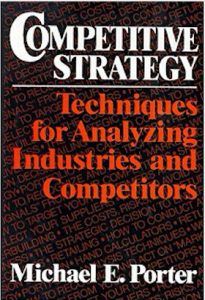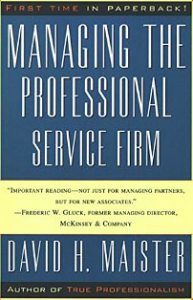From Maister to Porter – How the market for law firms has changed!
How the market for law firms has changed! Who would have thought we’d be applying Michael Porter’s Five Forces model to understand law firm strategy?
Let’s face it Porter’s Five Forces, which draws upon classical industrial organization economics, is a framework to understand and address the dynamics of competition and profitability in an industry populated with companies – not partnerships of professionals. But there has been a secular and irreversible change in the dynamics of the legal industry – a tectonic shift from a sellers’ to a buyers’ market that has transformed the very basis of industry rivalry.
Some of the core tenets of Porter’s thinking ring true for the legal industry, for example:
- Competitive intensity. This is driven by the increased bargaining power of buyers (i.e. clients), the threat of new entrants

(e.g. globalising law firms, the Big4 accounting firms etc.), the threat of substitutes (NewLaw models), and the bargaining power of suppliers (e.g. quality talent being prepared to go client side or work for NewLaw models). - Industry attractiveness and profitability. The legal industry, one of largely homogenous services where d
igital disruption is eroding the asymmetry of knowledge, is approaching a state of ‘pure competition’ – with the average level of profit being driven to an economic ‘normal’ profit. In other words the industry is becoming attractive only to those achieving significantly above-average
returns. The rest must face a new-normal of long term reduced profit. - Client service. In the long run these forces will impact how a law firm both services its clients and makes a profit. These forces will drive law firm strategies where they will re-assess their market and their role as an economic actor in that market.
- The nature of industry rivalry. This is where new business models will be explored nd deployed as a response to competitive rivalry. Law firms on the ascendency will identify and maximise their core competencies and modify their business model(s) to achieve above average profit.
 Maister’s 1993 seminal book Managing the Professional Service Firm identified five levers to generate sustainable profit. That work became the textbook for law firm business management and its logic and clarity must take some of the credit for the success of the traditional law firm model (BigLaw as it became known). But that model was based on old market conditions, most notably on an enduring asymmetry of knowledge and resulting ‘seller’ led market power. Much of Maister’s insights on the role of behaviour and relationships remain true today. But the business model underpinning BigLaw that was driven by the billable hour, rates of utilisation and recovery, and leverage needs to be reconfigured to be relevant to the new market conditions for law firms.
Maister’s 1993 seminal book Managing the Professional Service Firm identified five levers to generate sustainable profit. That work became the textbook for law firm business management and its logic and clarity must take some of the credit for the success of the traditional law firm model (BigLaw as it became known). But that model was based on old market conditions, most notably on an enduring asymmetry of knowledge and resulting ‘seller’ led market power. Much of Maister’s insights on the role of behaviour and relationships remain true today. But the business model underpinning BigLaw that was driven by the billable hour, rates of utilisation and recovery, and leverage needs to be reconfigured to be relevant to the new market conditions for law firms.
Remaking Law Firms is as it says. The book is a blend of conventional wisdom and prediction as to why law firm business models will change and how they can make the changes needed to preserve both their value to clients and profits for their owners. Up until recently the law industry was not dynamic; it was a constant. That has all changed. Porter gave us a valuable lens to make sense of these new dynamics, now Remaking Law Firms provides the fundamentals to understand what it all means to law firm leaders, and what you can do about it.
Author
Warren Riddell of Beaton Capital and Beaton Research + Consulting wrote this post. You can find Warren on LinkedIn, Twitter and Google+.


As we think about the future structure of the legal market and path of large law firms, I have long struggled with a question…
With no BigLaw supplier owning more than a couple of percentage points of market share, wouldn’t classical economics label the market as competitive? If so, then BigLaw prices would not include monopoly rent.
If BigLaw prices do include monopoly rent, then that suggests buyers see a series of much smaller, largely independent markets where specialists are scarce and can charge monopoly rent for their expertise.
Perhaps one way to think about the market is that the structure until recently allowed tying many non-monopoly services to the small monopoly element. With the rise of NewLaw and other alt suppliers, it is now easier for clients to unbundle. That is, they should be able to buy the monopoly component of the service they need (paying monopoly rent) with competitively priced services elsewhere.
Is this line of thinking correct? Helpful?
A very good observation Ron. What makes the current dynamic of the law industry so fascinating is that so many forces are working simultaneously. For example, disintermediation of the traditional holistic model (to which you refer), big new markets such as Asia changing both demand and supply globally, a switch from seller to buyer power, digital disruption – all a perfect storm of market change. I agree monopoly rents will be maintained in those areas that are sheltered from this storm and in new areas as they emerge and are scarce (the old price skimming model), but for the rest competitive intensity (as in Porter’s model) will become more pronounced. We are already seeing those law firms that can invest starting to operate on an omni-channel principle – a cluster of business models under one ‘corporatised’ whole. In effect de-constructing their original holistic one-business model approach and re-constructing into a cluster of business models to provide full service to their clients, drive differentiation and critically, remain relevant.
As an economist, I think Ron’s comment is correct. The BigLaw firms do have some advantages of bundling and being able to bring in a variety of services at low transaction costs. But client needs also have a structure to them. Yes, there is routine stuff and there even the BigLaw firms can compete with one another. But it is in the critical specialist stuff where the best is required to advocate in a dispute where the premium is likely to come into play. While those will be price constrained, the need for marginally better quality will allow higher margins for those with the best expertise.
(Joshua Gans holds the Jeffrey C. Skoll Chair in Technical Innovation and Entrepreneurship and is a Professor at the Rotman School of Management, University of Toronto. Ed)
Ron as Curator of Dialogue, I have taken the liberty of editing each of BigLaw and NewLaw into one word. This is the convention we use in NewLaw New Rules, Remaking Law Firms and our other writing. The usage is designed to connote the business models of these legal services providers, not their size or age. I trust this meets with your approval.
I will leave the debate about the degree to which the market/s for BigLaw services may have monopolistic features to others to comment on, at least for the time being. It’s a very good question.
Kind regards George
Ron, Your insight as usual is helpful, especially for some of us who are feeling an animal (not exactly an elephant) with limited scope of visibility, particularly when the animal is still taking shape! Having some experience many years ago participating in development of a tax software on a “bespoke” part of the U.S. income tax practice, I think the accounting and consulting firms have long pointed the way to reconstruct a significant part of a practice market, even with monopolistic characteristics, to unbundle even these markets across the spectrum that Richard Susskind has coined. The question that Rob Saccone pointed out before was when, not if, the investment will come for this exercise to take place in most of these previously monopolized markets. With the retirement of many experienced lawyers from the Baby-boom generation and new blood at or near the threshold of the legal profession, we may yet see a path for investors from either existing legal service providers or PE or VC players from outside the industry to activate similar changes. From an in-house perspective, the legal service supply chain, or we should say the value net (taking in a concept from competition theories), will undoubtedly march… Read more »